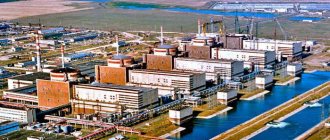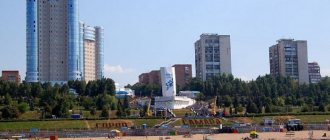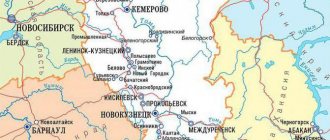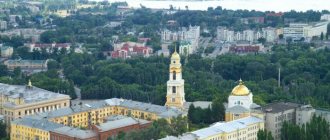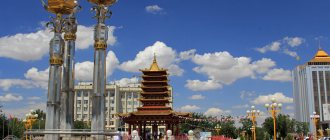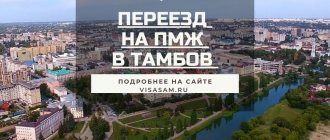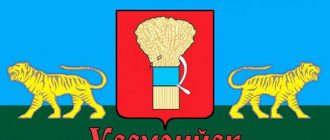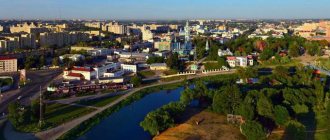Founded: 1574
City Day is celebrated
on June 12
.
Monument to the national hero of Bashkortostan Salavat Yulaev by sculptor S.D. Tavasiev (1967)
Ufa
– Russian city, capital of the Republic of Bashkortostan. The city is located on the banks of the Belaya River, at the confluence of the Ufa and Dema rivers, on the Pribelsky ridge-undulating plain, 100 km west of the ridges of the Bashkir (Southern) Urals.
Early history
the vicinity of Ufa goes back to the distant past, during the Old Stone Age (Paleolithic). The date of the city's foundation has been the subject of debate for centuries. Already in the Paleolithic era (20-30 thousand years ago) there were settlements of primitive people here. The Ufa hills and rivers are a magnificent natural defensive structure, which is why ancient fortified settlements are known on the so-called Ufa Peninsula.
In 1574, 17 years after the voluntary acceptance of Russian citizenship by the Bashkir tribes and the entry of Bashkiria into Russia, to strengthen the south-eastern borders of Russia, at the confluence of the Ufa and Belaya rivers, the Kazan governor Mikhail Alexandrovich Nagim founded the Ufa fortress, to the east of which there was not a single city until the Pacific Ocean.
Cathedral of the Nativity of the Virgin Mary (Photo: Bembikrat, ru.wikipedia.org) From a fortified city, Ufa gradually grew into the center of the region in the 17th and 18th centuries. In the 18th century, Ufa was part of the Kazan province, was the center of the Ufa province, and was part of the Orenburg province. Since 1802, Ufa became a provincial city with the residence of the governor and provincial institutions, and since 1865 - the center of the Ufa province.
In June 1922, the Autonomous Bashkir SSR, created in 1919, was annexed to the Ufa province, and Ufa became its capital.
Industry in Ufa appeared in the 19th century. The opening of regular navigation along the Belaya River in 1870 and the construction of the Samara-Zlatoust (now Kuibyshev) railway (1888-1892) gave a new impetus to the development of the city. Railway and ship repair shops, sawmills, and steam mills appeared in the city. By the end of the 19th century, there were about 30 factories and factories, and trade in bread and meat flourished.
At the end of the 1920-30s, the city began to develop rapidly, and gross industrial output increased 16 times. The Ufa Industrial Plant and light and food industry enterprises came into operation. During the first five-year plan, the Ufa Engine Plant and a thermal power plant were built. After the discovery of Bashkir oil in 1939, the Ufa Oil Refinery was built.
The Friendship Monument was founded in 1957 in honor of the 400th anniversary of the voluntary entry of Bashkiria into the Russian state.
During the Great Patriotic War,
dozens of industrial enterprises, some government agencies and research institutes were evacuated to Ufa from the western regions of the USSR.
In the post-war years, due to the expansion of oil production in the republic, new oil refineries were built in Ufa: the second (Novo-Ufimsky), and a few years later - the third. Ufa has become the largest oil refining center in the Volga region and the Urals. At the same time, the chemical industry and mechanical engineering developed in the city.
By Decree of the President of the Russian Federation dated July 2, 2022, Ufa was awarded the honorary title of Russian Federation for the significant contribution of city residents to achieving Victory in the Great Patriotic War of 1941–1945, ensuring uninterrupted production of military and civilian products at industrial enterprises, and for the massive labor heroism and dedication shown. Federation " City of Labor Valor"
».
Today Ufa
- the largest oil refining center in the Volga region and the Urals, a major transport hub, scientific, cultural and religious center of Russia. The main religious denominations are Islam and Orthodox Christianity. Ufa is the center of the Ufa and Sterlitamak diocese of the Russian Orthodox Church. Ufa is also the seat of the central authorities and the mufti of the Central Spiritual Administration of Muslims of Russia and the European CIS countries.
Congress Hall
Interesting facts
: The tallest building in the city is the office of Uralsib Bank. This is a 26-story building with a height of 100.5 meters. Ufa is the greenest million-plus city in Russia. There are 202 square meters of green space per resident. In Ufa, Svoboda Street ends with the “Dead End of Svoboda”.
Day of the city
celebrated in Ufa on June 12, simultaneously with two other significant holidays: Russia Day and Salavat Yulaev Days.
Where is Ufa located?
Ufa is a millionaire city. It is the twelfth most populous in the country. It is an important industrial and transport center of Russia. One of the key sectors of the city's industry is oil refining.
Where is Ufa located? The city is located on the banks of the Belaya River (the largest tributary of the Kama), not far from the conventional border between Europe and Asia, one hundred kilometers west of the Ural Mountains. Ufa is picturesquely located on quite high and beautiful hills (geographers will say more scientifically: on the Pribelsky ridge plain).
The city stretches strongly from north to south for as much as 53 kilometers. Visually, it can be divided into two halves – northern and southern. These two parts of one city are connected by a wide and very long October Avenue. However, Ufa residents call it as succinctly as possible - “prospect”.
Features of the holiday
The largest gathering place for citizens is the square named after. IN AND. Lenin. People gather here by 10:00. First, city hall employees give congratulatory speeches. Then children's ensembles take the stage one by one.
From 11:00 sporting events begin on the site in front of the Ufa Arena. The administration does not forget about people with disabilities. In 2018, a cultural and recreation park was allocated for them. M. Gafuri, where the festival with their participation opened from 12:00.
All day long, citizens and guests of the capital walk around the city, participating in various national holidays - Sabantuy, Shezhere, Bayramy. Attend craft and car exhibitions. And by 19:30 everyone gathers in the central square. Traditionally, a concert of famous artists is held there, and at 23:00 the festivities end with fireworks. For young people there is a disco, which usually lasts until 00:30.
Video 3. National holidays on City Day (2015)
Ufa city: time zone, time difference with Moscow and coordinates
Ufa is located within the local time zone “Ekaterinburg time”. It also includes a number of other large cities in Russia: Yekaterinburg, Perm, Kurgan, Chelyabinsk, Orenburg, Tyumen. The official (international) name of this time zone is UTC+5. The time difference with the Greenwich (zero) meridian is five hours, with Moscow – two hours. That is, when it is 9 am in the capital, it is already 11:00 am in Ufa.
The table below shows the exact geographical coordinates of the city of Ufa:
| Latitude of Ufa | 54° 44′ 00″ north latitude |
| Longitude of Ufa | 55° 58′ 00″ East longitude |
The total area of the city is 708 square kilometers. Administratively, it is divided into seven districts.
So, we found out where Ufa is located and what area it occupies. Now let's continue our acquaintance with this city of Russia.
Sights of Ufa on the map
Ufa has many parks and is considered one of the greenest cities. It is better to visit it in summer. However, it’s good here for the New Year too, as ural experts are convinced of. The city is beautifully decorated with New Year's illumination.
Ufa leaves a pleasant impression. This is a beautiful city with wide streets (to match the capital) and perfectly preserved old pre-revolutionary buildings. It is surrounded on both sides by large rivers – the Belaya and the Ufa. You can also feel the national flavor here. Signs and plaques are usually in Russian and Bashkir (and in some places also in English). Ufa definitely deserves to be here!
Descriptions and addresses of all Ufa museums can be found in a separate review.
Pavel Raspopov
See also:
- Objects of cultural heritage of the city of Ufa (list of architectural monuments)
- Suzdaltsev Victor. Pictures with the beauties of Bashkiria
- Blue Lake (Zyangyar Kul) near Ufa
- M. Somov. Description of Ufa (1864)
Sources: Wikipedia Dobreitsina L.E., Sannikova T.O. Historical cities of the Urals. Part 2. Historical cities of the Southern Urals. - Ekaterinburg, 2013. Ufa - 2GIS
Support Uraloved
Climate and ecology of Ufa
The city is located in the continental zone. Summers here are warm and a little capricious, winters are quite cold and long. The average annual air temperature in Ufa is 3.8 degrees. The absolute maximum was recorded in 1952 (+38.6), the absolute minimum in 1979 (–48.5). Up to 600 mm of precipitation falls in the city annually.
It is important to note that the climate of Ufa has noticeably softened in recent decades. Even in the coldest month of the year, January, air temperatures very rarely now fall below 20 degrees below zero. Nevertheless, by mid-November a stable and fairly thick snow cover forms in the city.
Unfortunately, the environmental situation in the city is far from ideal. Ufa is one of the ten most polluted cities in Russia. And this record does not make local residents very happy. It is especially difficult for residents of the Kalinin and Ordzhonikidze districts, where the level of air pollution with harmful emissions exceeds all permissible standards.
Coat of arms
The coat of arms of Ufa is presented in the form of a French shield. On a silver background there is a picture of a marten running on green ground. The animal has a natural brownish-brown color. The marten is facing the left side of the viewer. In the official drawing, you can see decorative elements on the “ground” - small T-shaped figures. They symbolize grass.
The coat of arms goes back to the historical version. It is allowed to frame it with a wreath of golden oak branches, leaves and acorns, over which a ribbon of the same metal is placed. At the top there is an inscription: “1574”.
The artistic composition is included in the State Heraldic Register of the Russian Federation under No. 3000. The author is S. Gilyazetdinov. Adopted by decision of the Ufa City Council of October 12, 2006 No. 16/4 (as amended on March 31, 2010). The description of the frame of the coat of arms was approved on May 17, 2007.
Population and economy of Ufa
Today, the city is home to 1.12 million people (within the so-called Ufa agglomeration there are even more – almost one and a half million). According to statistics, every fourth resident of Bashkiria lives here.
Ufa is a city in which various ethnic groups, mentalities and cultures are closely intertwined. Russians, Bashkirs, Tatars, Ukrainians, Chuvashs, Jews and representatives of several dozen other nationalities and nationalities coexist peacefully here. Since 2008, the population of Ufa has been steadily increasing, which means that the city has a future.
The city has developed oil refining, petrochemical, food and light industries, as well as mechanical engineering (in particular, instrument making). The largest oil refining complex, Bashneft, operates in Ufa. The depth of processing of black gold here reaches 84.9%.
With this rather rosy figure, we will finish our story about Ufa, an important industrial and cultural center of Russia, which has something to boast about and room to grow in the future.
UFA
Ufa. Panorama of the city. Photo by O. Menkov
UFA, a city in Russia, the capital of the Republic of Bashkortostan, the center of the urban district of the same name. Population 1124.2 thousand people (2019). Located on the river. Belaya (port), at the confluence of the Ufa and Dema rivers. Large transport hub. International Airport.
Story
A number of settlements are associated with the settlements that preceded Ufa (including Ufa-II, area approximately 2 hectares, with finds from the 4th/5th to 14th centuries), elite burials of the 5th–7th centuries. Turbaslinskaya culture. A number of researchers connect the medieval city with the settlement of Ufa-II, designated as Pascherti on the map of the Pitsigani brothers (1367), in the Catalan Atlas (1375), and later also on the map of G. Mercator (1554). Mentioned among the largest cities of the Golden Horde by an Arab author of the 14th century, it is also identified with it. Ibn Khaldun and others, Bashgird (Bashkort). In the 16th century on the site of modern U. there was Imen-kala (“oak city”) - the headquarters of the governor of the biys of the Nogai Horde in Bashkiria.
According to the most substantiated version, Uzbekistan was built as a Russian fortress in 1586 under the leadership of M. A. Nagoy (total area 1.2 hectares, wall length 440 m) (since the 18th century there has been a hypothesis about the foundation of Uzbekistan in 1574). Since the same year, the center of the county. From the end of the 16th century. used as a place of political exile. An important trading center on the way from the European part of the country to Siberia. In the mid-1660s - 1670s. A new fortress was erected, covering the entire territory of the city (the length of the walls is 2.4 km). District city of the Kazan province (1708–19), district city and center of the Ufa province, which was part of the Kazan province (1719–28, 1733–40) and the Orenburg province (1744–1781/82) and was directly subordinate to the Senate (1728–33) , 1740–44). In 1734–36, the seat of the head of the Orenburg expedition. In 1759, a significant part of the city was destroyed by fire. In November/December 1773 – March/April 1774 it withstood the blockade, as well as the assaults [12/23/1773(3/1/1774) and 1/25/1774] by the rebels during the Pugachev uprising of 1773–75. Center of the Ufa governorate (1781/82–1796), district city (1796–1802) and administrative center (1802–65) of the Orenburg province, center of the Ufa province (1865–1922). From the 2nd half of the 19th century. industry developed. In 1870, a permanent passenger steamship service began along the river. Belaya, traffic was opened on the railway lines Kinel - Ufa (1888) and Ufa - Zlatoust (1890).
In August 1917, the 2nd All-Bashkir Kurultai was held in Uzbekistan. Soviet power was established on October 26 (November 8), 1917. After the start of the 1918 Czechoslovak Corps, it came under the control of the Committee of Members of the Constituent Assembly on July 5, 1918. On September 8–23, 1918, the Ufa State Meeting of representatives of anti-Bolshevik governments took place in the city. In September - October 1918, seat of the Ufa Directory. On December 31, 1918 it was occupied by units of the Red Army, on March 13, 1919 – by white troops, on June 9, 1919 – again by the Red Army. Since 1922, the capital of the Bashkir Autonomous Soviet Socialist Republic (in 1990–92 the Bashkir SSR, since 1992 the Republic of Bashkortostan), the center of the canton (1922–30) and the region (since 1930). In the 1920s–30s. A number of large industrial enterprises were built, including an engine plant (now PO) and an oil refinery (1937; now part of the Bashneft company). Traffic was opened along the railway line Dema (now within the boundaries of Ukraine) - Ishimbayevo (1934). During the Great Patriotic War, in 1941–42, St. was evacuated to Ukraine from the western regions of the country. 40 industrial enterprises, the Presidium and most of the institutes of the Academy of Sciences of the Ukrainian SSR, a number of scientific institutions of the Academy of Sciences of the USSR and universities, the Kiev Academic Opera and Ballet Theater, etc. In 1944–56, the Stalinsky district of Uzbekistan was separated into the independent city of Chernikovsk; in 1955 traffic was opened on the Chernikovka – Zagorodnaya railway line. In 1952–53 the center of the Ufa region. In the 2nd half of the 20th century. developed as a large industrial center. Since 2006 the center of the urban district. City of Labor Valor (2020).
Architecture
The center of Uzbekistan is built up with rectangular blocks according to a regular plan (1803, architect W. Geste; revised in 1817–19). The following have been preserved: the Intercession Church (between 1808 and 1823), the Spasskaya Church (1824–44), the 1st Cathedral Mosque (1830), Gostiny Dvor (1825–66, project by A.I. Melnikov), the building of the theological seminary (1826–28 , 1840), governor's house (1832–38), wooden Church of the Exaltation (1890–93), Cathedral of the Nativity of the Virgin Mary (1901–09), People's House of S. T. Aksakov (1909–14, architect P. P. Rudavsky; completed in the 1920s and 1930s; now the opera and ballet theater), the mansions of E. A. Ponosova-Mollo (1910; now the Museum of Archeology and Ethnography of the Institute of Ethnological Research of the Ufa Scientific Center of the Russian Academy of Sciences), M. A. Laptev (1913; now Art Museum); in the Art Nouveau style - the house of P. I. Kosterin and S. A. Chernikov (1907–12, architect A. A. Shcherbachev) and the building of the Peasant Land Bank (1911–12; now the National Museum).
Palace of Culture named after G.K. Ordzhonikidze. 1955. Architect N. I. Shabarov. Photo by I. A. Malakhovsky
In the forms of modern neoclassicism - the House of Cooperation (1932–37, architect B. A. Korshunov), the Council of Ministers of the Bashkir Autonomous Soviet Socialist Republic (1937, architect N. S. Zarubin), the Pobeda (1945–49) and Rodina (1953) cinemas ; both - architect M. S. Yakshin), Palace of Culture named after. G. K. Ordzhonikidze (1955, architect N. I. Shabarov), Bashkir University (1958, architects B. G. and S. G. Kalimullin). Among the buildings of the last quarter of the 20th – early 21st centuries: the Palace of Culture “Khimik” (1975), the House of the Republic (1979), the Russian Drama Theater (1976–82), the Lyalya-Tulpan mosque (1989–98) and Salavat Yulaev (2007– 16), Congress Hall (2005–07, architects Kyokazu Arai, R.U. Mullagildin and others). Monuments: S. T. Aksakov (1959, sculptor T. P. Nechaeva), Salavat Yulaev (1967, S. D. Tavasiev), Miftakhetdin Akmulla, Z. G. Ismagilov (both 2008); the Friendship Monument in honor of the 400th anniversary of the annexation of Bashkiria to Russia (1965, M. F. Baburin, G. P. Levitskaya).
Centers of science and culture
Among the scientific institutions are the Academy of Sciences of the Republic of Bashkortostan (1991, it includes 15 scientific institutions), the Ufa Scientific Center of the Russian Academy of Sciences (history dates back to 1951). About 23 universities (including branches), including state universities: Bashkir (since 1909, modern status since 1957), aviation technical (1932, modern name since 2011), petroleum technical (1948, modern status since 1993), medical (1932), agricultural (1930, modern status since 1993), pedagogical named after. M. Akmulla (1967, modern status since 2000, name since 2006), etc.; institutes: legal (1970), arts named after. Z. Ismagilova (1968, current status since 2015). The largest library is the National Library. Akhmet-Zaki Validi (1921, modern name and status since 1992). Museums: national (1864), Bashkir State Art Museum. M. V. Nesterov (1919), geology and mineral resources (1934, modern status since 1999), national literary (1996), etc.; memorial - S. T. Aksakova, M. Gafuri.
Theatres: Bashkir Opera and Ballet Theater, Russian Drama Theater and Bashkir Theater named after. M. Gafuri (both 1919), dolls (1932), Nat. youth (1989, since 2006 named after M. Karim), Tatar “Nur” (1991; dramatic). State Philharmonic named after. Kh. Akhmetov (1939, modern name and status since 2010) has 2 concert halls: Small (organ; opened in 1948, an organ from the German company “Sauer” was installed in 1986) and Large (1984). The Philharmonic includes: State Academic Choir (1970), National Orchestra of Folk Instruments (2001), etc. National Symphony Orchestra of Bashkortostan (1992, name since 1994). Chamber orchestra "Bashkiria" (2011). Ensembles: folk dance named after. F. Gaskarova (1938), song and dance “Miras” (1992). International festivals: organ “Sauerfest” (since 2002, annually, modern name since 2015), jazz “Pink Panther” (annually, name since 2003), competition-festival of ensembles and orchestras of folk instruments “Call of the Urals” (2012, 2015, 2016 ). Open competition of performing musicians named after. N. Sabitova (since 1995).
Sport
The most famous clubs: in ice hockey "Salavat Yulaev" (founded in 1961) - 2-time champion of Russia (2008, 2011), winner of the Gagarin Cup (2011), one of the strongest clubs in the Continental Hockey League, hosts opponents at "Ufa- Arena" (opened in 2007; over 8 thousand seats); women's hockey team "Agidel" (2010) - champion of Russia 2022 and 2019; football club "Ufa" (2010) - since the 2014/15 season has been playing in the Premier League (best result - 6th place in the 2017/18 season), participant in the UEFA Europa League 2018/19, plays at the Neftyanik stadium (1967 ; over 15 thousand places); men's volleyball club "Ural" (1977) - silver medalist of the Russian Championship 2013, etc. Every year a stage of the World Championship in motorcycle ice racing is held (since 1966), and other major competitions. Since 1924, the Akbuzat hippodrome has been operating (after reconstruction in 2007, it became a universal equestrian complex). Among the largest international competitions held in the UK: European Biathlon Championships (2009), International Children's Games (winter in 2013, summer in 2019). In 2022, U. will host matches of the Women's Hockey World Championship, and in 2022 - the Volleyball World Championship.
Farm
One of the important Russian economic centers. Here are located the offices of companies in the field of production and processing of oil and natural gas (Bashneft), transportation of hydrocarbons and their products (Transneft-Ural, Gazprom Transgaz Ufa), etc.; branches of the largest Russian and foreign commercial banks, as well as leading Bashkir banks; large insurance, brokerage and leasing companies; retail facilities of large retail chains.
The basis of the city's economy is oil refining, petrochemicals, and mechanical engineering. Oil refining complex of the Bashneft company (includes 3 oil refineries, Bashneft-Novoil and Bashneft-Ufaneftekhim, the main products are diesel fuel and gasoline; processing volume is over 18 million tons of oil and gas condensate, 2018), Ufaorgsintez (polypropylene , liquid pyrolysis products, polyethylene, phenol), etc. Leading machine-building enterprises: engine-building software (part of the United Engine Corporation; the largest manufacturer of gas turbine engines in Russia; production of turbojet aircraft engines, helicopter components, production of equipment for the oil and gas industry); instrument-making software (on-board aviation and measuring equipment, medical equipment, automotive electronics), "Gidravlika" (products for the aviation and rocket and space industries), microelectronics plant "Magnetron" (communications equipment for special and civil purposes) and Bashkir PA "Progress" ( industrial electronics, telecommunications equipment and special-purpose communications equipment); the Promsvyaz plant and the Polygon Research and Production Enterprise (both produce telecommunications and other equipment), Ufimkabel. The production of rubber products (including emergency rescue equipment), paint and varnish products, finished medicines (Pharmstandard-Ufavita, Immunopreparat), cosmetic products, and household chemicals is also important; building materials, including wood; knitted and sewing products; dairy, meat and confectionery products, etc. Bashkir artistic crafts “Agidel” (painting on wood and porcelain and lacquer painting, sewing). 5 CHPPs, including Zatonskaya CHPP (2017), with a total installed capacity of approx. 1445 MW.
About the city
In the capital of the republic, more than 30 higher educational institutions operate annually, producing highly qualified specialists: State Oil University, Aviation Technical University, Bashkir State Institute; the presence of high-tech enterprises and large research centers. The basis of Ufa's economy is fuel and energy engineering organizations.
More than 200 industrial companies operate in Ufa. According to the integral rating of the republics of Russia, the settlement is called a zone of comfortable stay and ranks first in the ranking of prosperous families. Every year the All-Russian festival “Dairy Country” is held, a holiday dedicated to dairy products. Bashkir honey is the hallmark of the region.
The city is an important transport hub at the intersection of railways, air, river roads and pipelines. Ufa has the longest mainline railway point. The international airport was included in the ranking of the largest intercity organizations. The company is launching flights to the nearest points of Russia, far and near abroad.
Flag
The flag of Ufa is made in the form of a rectangular panel. The aspect ratio is 2:3. It consists of two horizontal stripes: the upper one is white, 7/10 wide of the same size of the panel, and the lower one is green. The first contains a marten in the center of a natural brownish-brown color.
The artistic composition was approved on September 6, 2007 (decision No. 26/4). Included in the State Heraldic Register of the Russian Federation under No. 3243.
What to see
Among the attractions of the city of Ufa are numerous monuments. One of them was installed to Salavat Yulaev, the national hero of Bashkiria and poet. An avenue in Ufa, the city of Salavat, and a hockey club are named after him. The weight of the monument is 40 tons. In memory of the 400th anniversary of the annexation of Bashkortostan to Russia, the Friendship Monument was opened in 1965. Two pink granite steles are held together by three gray granite rings. At the base are two bronze figures of women holding out laurel wreaths - a symbol of peace and harmony. Women personify Bashkortostan and Russia. In Victory Park there is a monument to Alexander Matrosov and Minnigali Gubaidullin, at the foot of which the Eternal Flame burns.
Among the attractions of the city of Ufa are museums. There are about 15 of them. Among them is the Bashkir State Art Museum named after M.V. Nesterov and the National Museum of the Republic of Bashkortostan, the House-Museum of the People's Poet of Bashkortostan Mazhit Gafuri and the Ethnographic Museum, as well as others. There are also memorial house-museums. To the 200th anniversary of the birth of S.T. Aksakov in 1991, the House-Museum of the writer was opened on his family estate. Nearby is a garden named after. S.T. Aksakov with a pond in which swans swim. Opposite the museum is a picturesque garden named after. Salavat Yulaev with a view of the Belaya River.
Civil architectural monuments include the buildings of the former Theological Seminary and the Assembly of the Nobility, the City Duma and the Peasant Bank. Unfortunately, many churches in the city of Ufa were closed and demolished. Among the surviving ones are the First Cathedral Mosque, the Cathedral of the Nativity of the Virgin Mary and St. Sergius Cathedral, the Intercession Church and some others. In the city of Ufa there are the State Opera and Ballet Theater and the Bashkir Academic Drama Theater, youth and puppet theaters and others. Gostiny Dvor, a shopping center of European level, is located in the historical and business center of Ufa. It occupies 40,000 sq.m of retail space, where about 70 stores are located, presentations and fashion shows are held. There is an illuminated fountain on the square in front of Gostiny Dvor. In the very center of the city is the Park named after. Ivan Yakutov. In addition to traditional attractions, there is billiards, a cafe, and a restaurant. You can relax on the lake.
Migration
Based on official data, from January to March 2022, migration in the city increased by 1,430 people. From 2022 to 2020, 26,274 people entered the territory of Bashkiria and 27,710 people left the republic.
From January to March 2022, 1,882 people entered Ufa. The locality attracts the attention of hundreds of citizens of the country due to several golden factors: high level of wages, free degree of solvency, availability of payment for services, availability of vacancies in both commercial and budgetary enterprises, well-developed infrastructure: schools, kindergartens, hospitals, universities, colleges.

